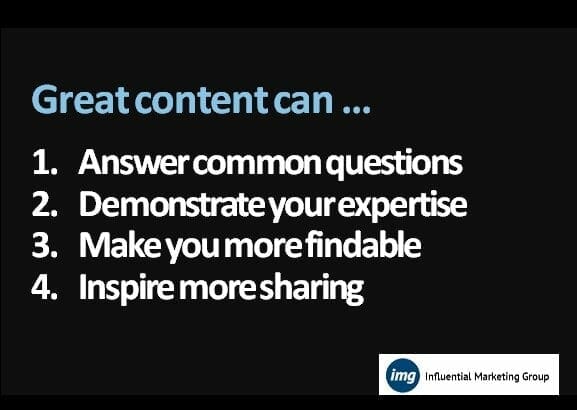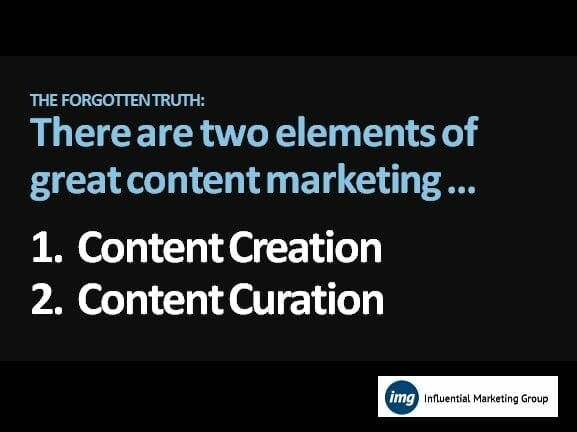There is a creation myth that we often hear when it comes to content marketing. It tells us that in order to provide value with the content we produce, we need to create answers to questions. We need to create continually updated events, articles, videos, or images. Create, create, create. But creation is hard. Not everyone is a great writer. No one is born with the ability for powerful photographic composition. And despite more and more tools making previously complex tasks like video editing easier, simplicity of creation doesn’t lead to proliferation of talent.
Just because you can easily create content doesn’t mean your content will be good.
4 Benefits of Great Content:
- Answer common questions
- Demonstrate your expertise
- Make you more findable
- Inspire more sharing

There is a predictable downside to more content creation online – and it the corresponding increase in noise that it creates. More than ever before, it has become impossible to separate the great content from the bad, because it is presented in a waterfall format with the reader sitting hopeless underneath. Even if you did have the right talent, just creating better content doesn’t always solve this noise problem because people can’t always find it.
What if there was a way to use content for marketing that didn’t require you to become a writer, actor, director or producer overnight – and could also solve the problem of rising above the noise? There is already a solution for both – and involves the forgotten truth that there are actually two sides to great content marketing: creation AND curation.

I have written before about the 5 models for content curation (aggregation, elevation, distillation, mashups, chronology) and the opportunity they offer to make sense of what is available on the web and bring more meaning to that content in multiple ways.
A Definition of Content Curation:
Content Curation is a term that describes the act of finding, grouping, organizing, or sharing the best and most relevant content on a specific issue.
Here is the best part about content curation, though. It doesn’t require you to be a writer, or a filmmaker, or an on-screen commentator. Curation is inherently behind the scenes. What it does require, though, is expertise. It requires the ability to think and collect. They are different skills sets than creation, but in a business environment – it is far more likely that you will find someone with deep subject matter expertise in a particular industry, topic or issue. They may not necessarily be gifted writers or documentarians, but their expertise is their strength and though creating original content may be an uphill battle – curating highly valuable content available elsewhere can be a much more realistic goal.
The bottom line is, great content marketing doesn’t always require creating it from scratch. Sometimes expertise means helping shine a spotlight on what matters instead of creating it yourself.






















Great article! You make a very valid point regarding content curation. If I had more time I would love to write more but with all my daily commitments it makes it tough to create compelling content that people will actually find useful and inspire them to share. While not creating content on a regular basis I try to read a variety of articles/blogs everyday to stay on top of trends and I find sharing these articles to my network mutually beneficial. Shining a spotlight on the content is providing value to your network and can position you as an expert in a specific industry.
Rohit, thanks for sharing your view. Even if I don’t share 100% your view on this, I continue to remain thankful for the good work you keep producing.
I’d like to be a little provocative though this time and to question with you this increasingly popular idea that content curation can be a valid and beneficial substitute for content writing.
My fear is that by positioning “content curation” as a solution for those who can’t write may provide a fast-food solution to hungry content marketers, while not really achieving any of the original benefits you have long and correctly envisioned for content curation itself.
My point is: how far can you go in persuading people that curation is an effort that requires less time and skills than writing?
In my limited experience, unless we are just aggregating, the opposite is true, as content curation, is a much more demanding and multi-disciplinary activity than blog writing, for example, is.
As a matter of fact, if I look back at your original 5 models for content curation (aggregation, elevation, distillation, mashups, chronology), only aggregation can be done without having any additional skills besides picking and reposting.
My question for you Rohit is this: how can someone produce valuable content with curation unless he first develops the skills of online searching, vetting, comparing, synthesizing/summarizing and providing personal insight?
Robin,
Thanks so much for the insightful comment. You make a great point that probably justifies another post on the skills that are really required to be a good curator. And the “fast food” problem is one that is definitely a danger in positioning curation as easier than creation. Probably a better way to look at it is that good curation takes DIFFERENT skills than creation.
And I happen to believe the main skill that makes curation work is subject matter expertise … which is WAY more common than talent in creation, as long as the people doing it are curating information on topics that they know very well.
Curation won’t work if you don’t pair it with expertise.
But if you do, then I think it’s a viable alternative to content creation and many more people within an enterprise can get involved in the execution of a content marketing plan.
Thanks Rohit for clarifying this. I agree 100% that subject matter expertise is THE critical variable, but I have strong doubts that good curation, beyond lists and aggregation can be carried out successfully without mastering the ability to research, synthesize, and illustrate the very stuff that is being curated.
I very much hope Rohit will give us his post on the skills needed for good content curation.
Robin, your starter list sounds the first part of what educators call “digital literacy” these days. I share your concern about a fast-food approach to content marketing. But I’m equally concerned that using words like “mastering,” “demanding,” and “multi-disciplinary” – especially with the assertion that they must be developed first – may scare off relative newcomers to a topic who possess what I think is another core attribute of good curation: curiosity.
Might there be a sixth model for curation: exploration? I’m thinking of someone who comes upon content that sparks a (for her) new line of inquiry and might quickly pull together a few additional links, summarize the question(s) raised, and post them as the jumping off point for a shared journey of discovery.
For content marketing, few things seem better for building a “know, like, and trust” relationship with customers and referrers than candidly admitting you don’t (yet) know an answer, but showing you know how to find out.
Hello Tom, good points.
To be honest, I am not particularly keen in getting lots of newcomers in, with this content-marketing expectation that they can do more while saving lots of time. I think they are being sold on a false premise.
Re the “exploration” model, I agree with you 100% that it is a valid additional curation model, as there are definitely a few more beyond the original six Rohit so skillfully identified.
Yeah, Robin, I agree that saving a lot of time with curation is probably illusory. My notion of an exploration model might well save time up front in getting a post published, but require spending more time in the comment stream (leading and following) and maybe follow up posts as the expedition yields discovery.
For a marketer, though, that could be a more valuable investment of time than creating original articles, no?
Absolutely yes.
What a great article!.
Thank you Rohit. I can really relate to this topic. I am a content curator. I have been exploring and sharing content that I am passionate about for more that a year now. For the past six weeks,I am focussed on creating content together with visuals using dynamic visual curation tool, Clipzine. Thanks to Robin Good for curating about it on ScoopIt.
I shared my visual curation using jpg image across popular social media sites. The collage looks great on Pinterest, Facebook and Google+. It gets better attention and responses compared to just doing plain content curation. I also get a lot of compliment which is suprising. I communicated back by asking if these new contacts read the articles and some replied in length saying that the visual curation really making great impact on the content curation and the curator. Here’s my recent curation about this article; https://llatipi.blogspot.com/2013/07/content-curation-how-to-use-content.html
Thanksfor the explanation. I often find I’ve beendoing a process on my own for quite some time but then it gets renamed and I’m at a loss. Content Curation can certainly make it easier to find specific information.
Let me just add that curation is most powerful when accompanied by a strong editorial voice. Curators should look for tools that make their own perspectives the focal point – rather than the content they are referring to. Otherwise, you’re just amplifying the noise.